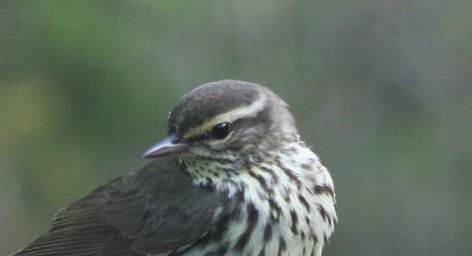Jeffrey Boone Miller

Northern Waterthrush. Photo credit: Joppa Flats Bird Banding Station.
How much habitat does a migrating bird need? If it’s a waterthrush and conditions are right, the answer: is not very much.
On June 4, 2008, in Watertown, Massachusetts, I had an unusual opportunity to closely observe a Northern Waterthrush (Parkesia noveboracensis) for several hours. My office overlooked a 25-foot-wide strip of asphalt that was bordered by our three- story building on the south and by a 100-foot-wide strip of woods on the north. A four- foot-high wire mesh fence separated the pavement from the trees.
On that day of continuous light rain and a temperature of 70°F, runoff had created a shallow stream, one to two feet wide and less than an inch deep, that flowed on the asphalt parallel to a shallow curb by the fence. At approximately 9:30 am, I was surprised and delighted to find a Northern Waterthrush walking in this flowing water.
For the next six hours, I checked for the waterthrush multiple times, with a cumulative observation time of about 30 minutes. I quickly found the bird every time I looked. It was always walking in or near the runoff or within the first three to five feet of the neighboring woods, and it stayed within a 30-foot segment of the running water. If a car passed, the bird ducked through the fence and into the trees. This bird stayed for several hours within a total area of less than 200 square feet.
Perhaps the waterthrush stayed in this small area because of a high density of prey. When walking in the stream, the bird seldom had to travel more than two or three feet before locating a prey item, most of which were small, light-colored caterpillars less than a half inch long. Feeding success appeared to be much lower when the bird was in the nearby vegetation.
These prey items likely originated in the overhanging black locust (Robinia pseudoacacia) trees that had been in spectacular and aromatic bloom for several days. In previous days, a steady procession of birds had been feeding on larvae among these blooms. The day’s rain knocked large numbers of flower petals into the newly formed runoff stream, so it seems likely that prey items arrived with the petals and that additional prey items were washed into the runoff throughout the day.
Northern Waterthrushes have a strong preference for riparian habitat and will defend a territory of one to several acres on their nesting grounds (Whitaker and Eaton 2014). For at least this one day, however, the tiny patch of artificial and ephemeral riparian habitat outside my office apparently provided all this particular bird required.
Reference
- Whitaker, D. M. and S. W. Eaton. 2014. Northern Waterthrush (Parkesia noveboracensis). The Birds of North America Online (A. Poole, Ed.). Ithaca: Cornell Lab of Ornithology; Accessed 01/16/2016.
Jeffrey Boone Miller is a Professor of Neurology and Physiology at the Boston University School of Medicine, a member of the Board of Tutors in Biochemical Sciences at Harvard University, and an Associate Editor of Bird Observer. Jeff is an advocate for birding locally and habitat preservation.